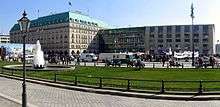Pariser Platz
Pariser Platz is a square in the centre of Berlin, Germany, situated by the Brandenburg Gate at the end of the Unter den Linden. The square is named after the French capital Paris in honour of the anti-Napoleon Allies' occupation of Paris in 1814, and is one of the main focal points of the city.
History






Pariser Platz is the square immediately behind the Brandenburg Gate when approaching the centre of Berlin from the Tiergarten in the west. The neo-classical Brandenburg Gate was completed in the early 1790s by Carl Gotthard Langhans. Until 1814 the square was known simply as Quarré or Viereck (the Square). In March 1814, when Prussian troops along with the other Allies captured Paris after the overthrow of Napoleon, it was renamed Pariser Platz to mark this triumph.
The Brandenburg Gate was the main gate in the western side of the Customs Wall that surrounded the city in the eighteenth century, and the Pariser Platz is at the west end of the avenue of Unter den Linden, the ceremonial axis of the city, down which the victorious troops of all regimes from the Hohenzollerns to the German Democratic Republic have marched in triumph.
Before World War II, Pariser Platz was the grandest square in Berlin, flanked by the American and French embassies, the finest hotel (the Adlon Hotel), the Academy of the Arts, and several blocks of apartments and offices.
During the last years of World War II, all of the buildings around the square were turned to rubble by air raids and heavy artillery bombardment. The only structure left standing in the ruins of Pariser Platz was the Brandenburg Gate, which was restored by the East Berlin and West Berlin governments. After the war and especially with the construction of the Berlin Wall, the square was laid waste and became part of the death zone dividing the city.
When the city was reunited in 1990, there was broad consensus that the Pariser Platz should be made into a fine urban space again. The embassies would move back, the hotel and arts academy would be reinstated, and prestigious firms would be encouraged to build round the square. Under the rules of reconstruction, eaves heights had to be 22 meters, and buildings had to have a proper termination against the sky. Stone cladding was to be used as far as possible. Interpretations of these constraints, however, have varied to a great extent.
Buildings on Pariser Platz
The following is a partial list of buildings and structures on Pariser Platz, working anti clockwise from the Brandenburg Gate:
- Brandenburg Gate
- Haus Sommer, used by Commerzbank
- U.S. Embassy
- Palais Wrangel, used by DZ Bank
- Academy of Arts, Berlin
- Brandenburg Gate Museum
- Hotel Adlon
- French Embassy
- Eugen-Gutmann-Haus, used by Dresdner Bank
- Palais am Pariser Platz
- Haus Liebermann
In the vicinity of Pariser Platz are:
- North: Reichstag building and government district
- South: Memorial to the Murdered Jews of Europe
- Southeast: British Embassy at Wilhelmstrasse
- East: Embassies of Russia and Hungary at Unter den Linden
Notable residents
- Achim von Arnim, poet and novelist
- August von Kotzebue, dramatist
- Max Liebermann, painter
- Giacomo Meyerbeer, composer
- Friedrich Karl von Savigny, jurist (Historical School)
- Albert Speer, architect, Nazi minister for armaments
- Friedrich von Wrangel, Prussian Generalfeldmarschall
Transport
Near the square is located the Brandenburger Tor underground station which is served by the Berlin S-Bahn S1 line, and is the temporary terminus of the U55 U-Bahn line. The S-Bahn station was opened in 1936 with the name Unter den Linden and was closed in 1961 with the construction of the Berlin Wall, becoming one of Berlin's ghost stations. It reopened on September 1, 1990.
The square itself is closed to automobile traffic, but is served by local bus lines nearby.
References
- In Pariser Platz - design and construction of town square in Berlin, Germany, by Anne Vyne, in The Architectural Review, No. 1, 1999.
External links
| Wikimedia Commons has media related to Pariser Platz. |
- Pariser Platz - Interactive 360° Panorama

